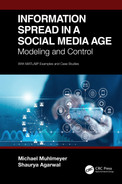List of Figures
4.2 A three-node relationship mapping of individuals 1,2, and 3.
6.1 Microscopic and macroscopic modeling of vehicular traffic.
7.10 Sample evolution of the Ignorant-Spreader-Ignorant model.
7.11 Flow diagram for the Ignorant-Spreader-Recovered model.
7.16 Sample time evolution of the ISR model for social media.
7.25 Spreader is stifled twice as strongly as a counter-spreader.
7.28 Hybrid ISCR groups: dominant spreader & counter-spreader.
7.32 Hybrid ISCR groups: skewed receptivity between the groups.
7.35 ISSRR scenario: minor influence of Group 2 over Group 1.
9.2 Flow diagram for an event-triggered social chatter model.
9.3 Event-triggered social media chatter model without control.
10.4 Normalized daily tweet volume of event triggered hashtags.
10.6 Simulation results: event-triggered chatter on #Shooting.
10.7 Normalized daily tweet volume of social campaign hashtags.
13.1 Social and technical subsystems as socio-technical systems.
14.2 Control trajectories for intermittent and optimal control.
